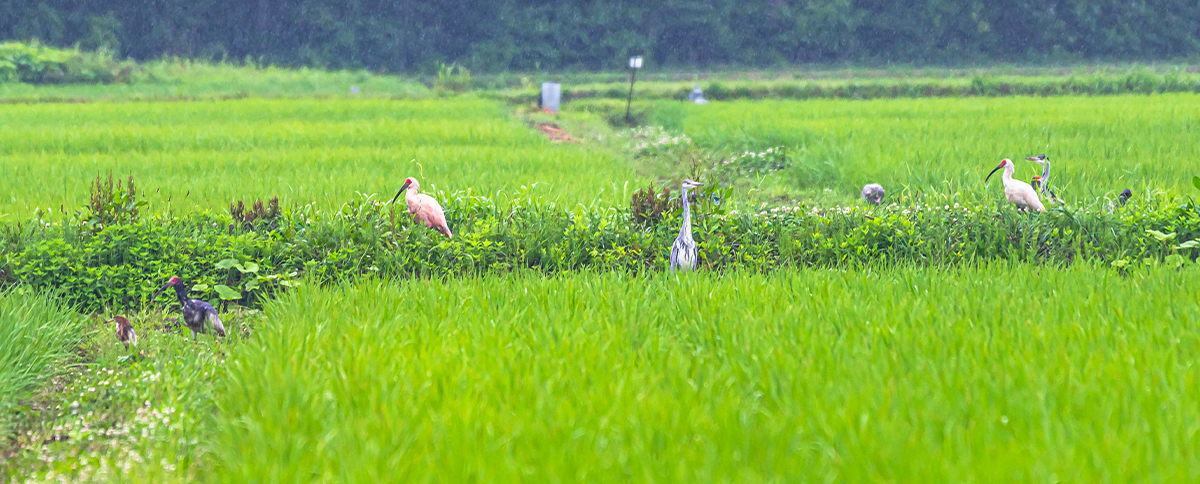- Feature
- “Toki’s Island,” a Wild Bird Paradise
“Toki’s Island,” a Wild Bird Paradise

Sado, located in the Sea of Japan, is the perfect stopover for migratory birds. Thanks to the ocean currents, summer is cooler and winter is warmer on Sado than on the mainland, add to that the richly preserved natural environment and you have a comfortable resting site for birds. At this point, about 360 species of birds have been sighted. In addition to about 50 species of resident birds, various “visiting” birds fly over to Sado for rest and propagation throughout the year.
A variety of birds can be observed on Sado Island throughout the year.
See below for further details.
Rice paddies are a happening social hotspot for birds.
The Kuninaka Plain, which sprawls in the center of Sado, is where tokis, herons, migratory and other birds alight to feed. On Sado Island, various efforts are being made in the hope that human beings can coexist more respectfully with nature. Farming methods that encourage living creatures include not only reducing the use of chemicals, but also filling rice fields with water even in winter, and creating deeper points in water channels to provide refuge for water dwellers.
These efforts allow numerous creatures to thrive in rice fields, creating a favorable environment for wild birds in every season. Around the plain, white-tailed eagles and falcons can be observed, too, stalking their prey with a vigilant eye.

Various birds visit throughout the year.

You can see birds of prey like falcons, too.
Look for herons if you want to see tokis (crested ibises).
Sado islanders are often disappointed when they find white birds in a rice paddy and excitedly think they have sighted tokis, only to notice that the birds are herons after all. Herons, with the slightly unfavorable Japanese name “sagi,” (which can also mean “fraud” or “to swindle”), have a humorous appearance and very amiable eyes. Tokis and herons, whose habitat and areas of activity are similiar, are often seen side by side, looking for feed in rice fields or taking a rest on the ridges between paddies. So, where herons can be found, ibises can usually be found, too. Herons can be good landmarks since they are less timid than tokis, and allow humans to come closer.

Herons and tokis get along well with each other in rice paddies.

Tokis can often be found in the inner parts of rice paddies.
An encounter with a bird or birds is a once-in-a-lifetime experience.
In spring and fall, a large number of migratory birds fly over to Sado Island. The place around Hajikizaki at the northern tip of Sado is famous as a place where migratory birds stay. Especially in spring, birds heading for the north stop over for a little rest and feed. Many birds also take a rest around Niibo Dam, and local bird lovers hold bird-watching expeditions.
On Sado Island, where communities dot the mountains and seaside, rare birds can often be found close to private residences. If you speak to local people, they may tell you about nearby spots where wild birds can be found, or about their personal bird watching experiences.
Bird watching depends greatly on luck and timeliness. That may be why your delight is especially great when you have encountered exactly the bird you have been looking for.
Sado has many kinds of rare residential birds, too, like Sado-kakesu, an endemic subspecies of jay. Presumably, many people want to see wild tokis more than anything else. The release of tokis to the wild and the birth of chicks to wild parents have given us more opportunities to see tokis, even in the plains. But that does not necessarily ensure that you will encounter them.
If you happen to miss seeing them, please visit the “Toki Rapport Plaza,” where you can observe tokis right before your eyes.

In early spring, hoepoes come to Sado, too.

Sado-kakesu, a subspecies of jay
References: “Toki no Shima no Yacho” (Wild birds on Toki’s Island), by the Sado Chapter of the Wild Bird Society of Japan
Photo credit: Yoshiyuki Ito and the Wild Bird Society of Japan, Sado Chapter